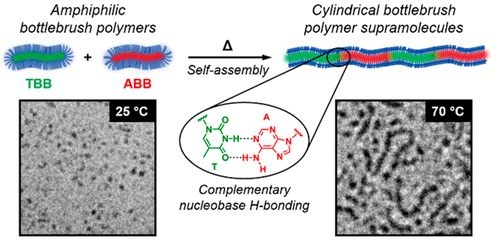当前位置:
X-MOL 学术
›
Macromolecules
›
论文详情
Our official English website, www.x-mol.net, welcomes your feedback! (Note: you will need to create a separate account there.)
Complementary Nucleobase Interactions Drive the Hierarchical Self-Assembly of Core–Shell Bottlebrush Block Copolymers toward Cylindrical Supramolecules
Macromolecules ( IF 5.5 ) Pub Date : 2020-11-10 , DOI: 10.1021/acs.macromol.0c01857 Spyridon Varlas 1 , Zan Hua 2 , Joseph R. Jones 1 , Marjolaine Thomas 1 , Jeffrey C. Foster 1 , Rachel K. O’Reilly 1
Macromolecules ( IF 5.5 ) Pub Date : 2020-11-10 , DOI: 10.1021/acs.macromol.0c01857 Spyridon Varlas 1 , Zan Hua 2 , Joseph R. Jones 1 , Marjolaine Thomas 1 , Jeffrey C. Foster 1 , Rachel K. O’Reilly 1
Affiliation

|
The self-assembly of amphiphilic block copolymers has facilitated the preparation of a wide variety of nano-objects of diverse morphology. Ready access to these nanostructures has opened up new possibilities in catalysis, sensing, and nanomedicine. In comparison, the self-assembly of large building blocks (i.e., amphiphilic bottlebrush polymers) has received less attention, owing in part to the relatively more challenging synthesis of these macromolecules. Bottlebrush amphiphiles can self-assemble into uniquely stable spherical nanostructures and can also produce dynamic cylinders with lengths modulated by environmental conditions, motivating further research in this area. Herein, we report the synthesis of core–shell bottlebrush polymers (BBPs) containing complementary nucleobase functionalities via a combination of ring-opening metathesis polymerization (ROMP) and reversible addition–fragmentation chain transfer (RAFT) polymerization, using a “grafting-from” approach, and their hierarchical self-assembly in aqueous media. Mixtures of BBPs containing thymine or adenine units in their core blocks were found to self-assemble into higher-order cylindrical supramolecules upon heating above a critical temperature. This temperature was demonstrated to correspond to the lower critical solution temperature (LCST) of the corona-forming poly(4-acryloylmorpholine) block, providing evidence for a unique one-dimensional BBP assembly mechanism. Moreover, the formation of extended supramolecular assemblies was preferentially observed when both thymine- and adenine-functionalized BBPs were present in equimolar concentrations, pointing toward an alternating, isodesmic mechanism of organization occurring via nucleobase interactions located at their chain termini. We anticipate that these discoveries will provide the basis for future studies regarding BBP self-assembly, especially with regard to the formation of stimuli-responsive anisotropic nanostructures.
中文翻译:

互补的核碱基相互作用推动了核-壳型瓶刷嵌段共聚物的分层自组装向圆柱超分子的方向发展
两亲性嵌段共聚物的自组装促进了各种形态多样的纳米物体的制备。易于使用这些纳米结构为催化,传感和纳米医学开辟了新的可能性。相比之下,由于这些大分子的合成相对更具挑战性,大型构件(即两亲的牙刷聚合物)的自组装受到的关注较少。洗瓶刷两亲物可以自组装成独特的稳定球形纳米结构,还可以生产动态圆柱体,其长度受环境条件调节,从而推动了这一领域的进一步研究。在这里 我们报告了通过开环易位聚合(ROMP)和可逆加成-断裂链转移(RAFT)聚合(使用“从-接枝”方法)的组合,合成了包含互补核碱基功能的核壳型瓶刷聚合物(BBP),及其在水性介质中的分层自组装。发现在核心温度以上加热时,在其核心嵌段中含有胸腺嘧啶或腺嘌呤单元的BBP混合物会自组装成高阶圆柱超分子。该温度被证明对应于形成电晕的聚(4-丙烯酰基吗啉)嵌段的较低临界溶液温度(LCST),从而为独特的一维BBP组装机理提供了证据。此外,当胸腺嘧啶和腺嘌呤官能化的BBP都以等摩尔浓度存在时,优先观察到延伸的超分子组装体的形成,这表明通过位于其链末端的核碱基相互作用,发生了交替的组织学机制。我们预期这些发现将为有关BBP自组装的未来研究提供基础,尤其是在刺激响应各向异性纳米结构的形成方面。
更新日期:2020-11-25
中文翻译:

互补的核碱基相互作用推动了核-壳型瓶刷嵌段共聚物的分层自组装向圆柱超分子的方向发展
两亲性嵌段共聚物的自组装促进了各种形态多样的纳米物体的制备。易于使用这些纳米结构为催化,传感和纳米医学开辟了新的可能性。相比之下,由于这些大分子的合成相对更具挑战性,大型构件(即两亲的牙刷聚合物)的自组装受到的关注较少。洗瓶刷两亲物可以自组装成独特的稳定球形纳米结构,还可以生产动态圆柱体,其长度受环境条件调节,从而推动了这一领域的进一步研究。在这里 我们报告了通过开环易位聚合(ROMP)和可逆加成-断裂链转移(RAFT)聚合(使用“从-接枝”方法)的组合,合成了包含互补核碱基功能的核壳型瓶刷聚合物(BBP),及其在水性介质中的分层自组装。发现在核心温度以上加热时,在其核心嵌段中含有胸腺嘧啶或腺嘌呤单元的BBP混合物会自组装成高阶圆柱超分子。该温度被证明对应于形成电晕的聚(4-丙烯酰基吗啉)嵌段的较低临界溶液温度(LCST),从而为独特的一维BBP组装机理提供了证据。此外,当胸腺嘧啶和腺嘌呤官能化的BBP都以等摩尔浓度存在时,优先观察到延伸的超分子组装体的形成,这表明通过位于其链末端的核碱基相互作用,发生了交替的组织学机制。我们预期这些发现将为有关BBP自组装的未来研究提供基础,尤其是在刺激响应各向异性纳米结构的形成方面。



























 京公网安备 11010802027423号
京公网安备 11010802027423号